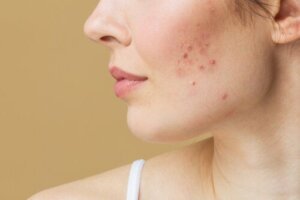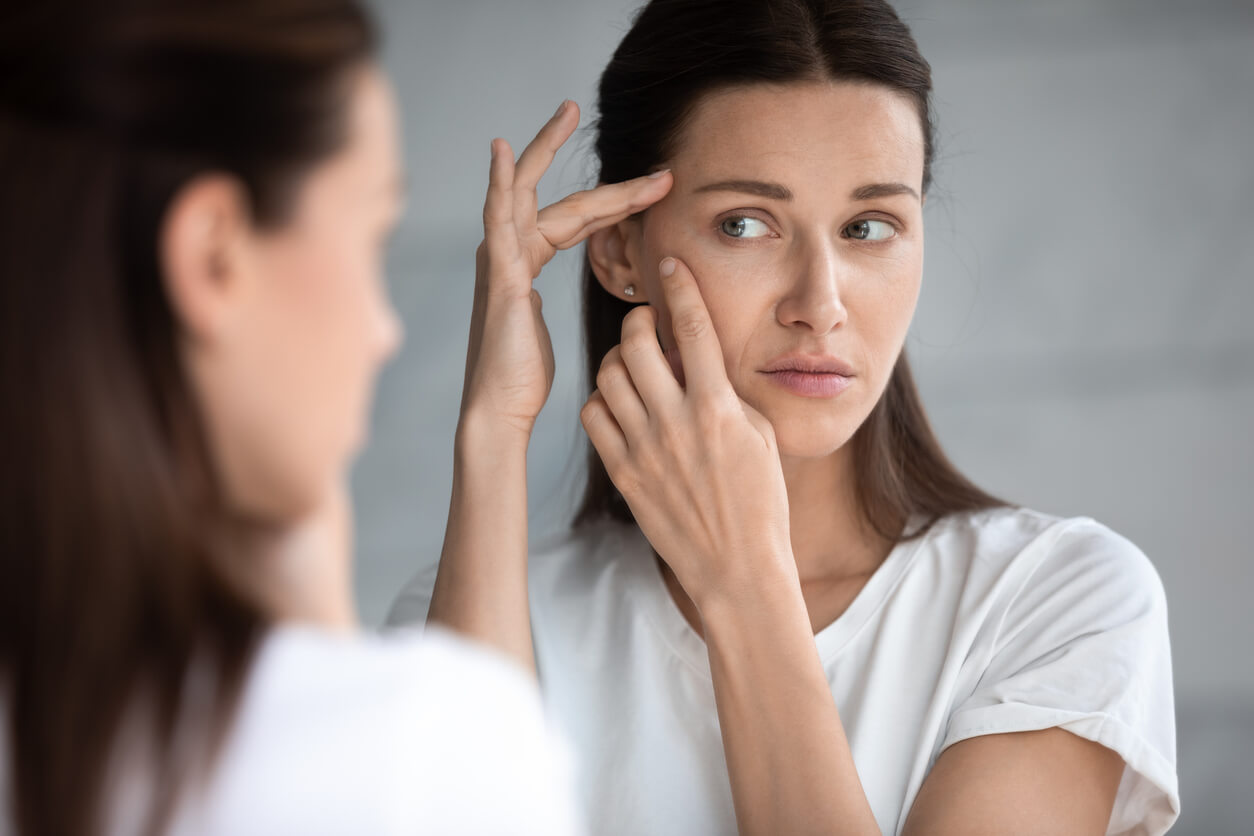Postpartum Acne: Causes and Treatment


Written and verified by the dermatologist Maria del Carmen Hernandez
Postpartum acne is one of the most common manifestations after childbirth. Although it’s not a serious condition that presents complications, it’s important to know why it’s triggered and how to manage it.
Here are the main characteristics of postpartum acne.
The causes of postpartum acne
Acne isn’t only a problem for teenagers but also for pregnant and postpartum women. In fact, it’s normal to have some active lesions on the face after the baby’s born.
Acne breakouts are associated with alterations in hormone levels (progesterone and estrogen). When hormone levels are elevated, sebum production by the sebaceous glands increases and pores become clogged. The most frequent areas of localization are on the face, cheeks, chin, and forehead.
The progesterone hormone
Progesterone is a female sex hormone produced by the ovaries to maintain a healthy pregnancy. However, after childbirth, progesterone levels return to normal, although it doesn’t take all women the same amount of time. Therefore, some women may develop acne.

The stress hormone
It’s not only hormonal alterations that cause postpartum acne. In fact, the new life routine and the adaptation to the new baby can increase stress levels and be another cause of acne.
Stress isn’t what causes the lesions directly, but in this condition, a large amount of cortisol is released. In turn, this stimulates the production of sebum by the sebaceous glands.
You may be interested in: 10 Interesting Facts About Your Skin When You’re Pregnant
Therapeutic options for postpartum acne
In general, acne that’s triggered during pregnancy tends to resolve spontaneously after delivery. However, some women may continue to have active lesions after the baby’s born.
Hydration and nutrition
Postpartum acne outbreaks can be triggered by dehydration. That is, dry skin stimulates increased sebum production.
It’s important to increase fluid intake during the day and keep the body hydrated. It’s also advisable to perform the necessary skin hygiene and moisturizing to keep the skin healthy. In addition, a complete and varied diet is also important and plays a fundamental role in maintaining healthy and functional skin.
Topical treatments
Topical treatments are useful when acne doesn’t improve during the postpartum or breastfeeding stage. While they’re not safe to use during pregnancy, topical retinoids are may be prescribed during the post-pregnancy period, which act as anti-inflammatory and antimicrobial agents that clean the pores on the skin surface.
Salicylic acid can also be used, as it exfoliates the top layer of the skin and removes dead skin cells to unclog pores. In addition, benzoyl peroxide is an effective antibiotic to combat inflammatory acne.

Hygiene and care routines for postpartum acne
Modifications to certain care and hygiene routines can make a significant difference to the quality of the skin. In this regard, choosing non-oily cosmetics and adding them after applying skincare products is a good option.
Exfoliation is key in order to remove dead skin cells. Also, peels can be useful, as long as you take into consideration the acids used in the procedure. Keep in mind that vitamin A derivatives, such as retinoic acid, aren’t recommended, while glycolic acid in low concentrations and azelaic acid are excellent options.
Read also: Quick Beauty Rituals for Busy Moms
Facial masks
There are several types of facial masks aimed at different skin needs, such as reducing pores, dryness, oiliness, or nutrition.
Clay facial masks are useful for detoxifying, illuminating, softening, and exfoliating the skin’s surface. In addition, they remove all impurities and give the face a healthy and delicate glow. Apart from this, they diminish excess sebum, dust, and dirt.
Postpartum acne is a temporary condition
Postpartum acne is usually mild and disappears soon after the birth of the baby. The vast majority of women develop lesions after pregnancy, regardless of whether or not they breastfeed.
At the same time, using home remedies isn’t recommended for treating elementary acne lesions. Although it’s a condition that resolves over time, a dermatologist can be consulted if necessary.
Postpartum acne is one of the most common manifestations after childbirth. Although it’s not a serious condition that presents complications, it’s important to know why it’s triggered and how to manage it.
Here are the main characteristics of postpartum acne.
The causes of postpartum acne
Acne isn’t only a problem for teenagers but also for pregnant and postpartum women. In fact, it’s normal to have some active lesions on the face after the baby’s born.
Acne breakouts are associated with alterations in hormone levels (progesterone and estrogen). When hormone levels are elevated, sebum production by the sebaceous glands increases and pores become clogged. The most frequent areas of localization are on the face, cheeks, chin, and forehead.
The progesterone hormone
Progesterone is a female sex hormone produced by the ovaries to maintain a healthy pregnancy. However, after childbirth, progesterone levels return to normal, although it doesn’t take all women the same amount of time. Therefore, some women may develop acne.

The stress hormone
It’s not only hormonal alterations that cause postpartum acne. In fact, the new life routine and the adaptation to the new baby can increase stress levels and be another cause of acne.
Stress isn’t what causes the lesions directly, but in this condition, a large amount of cortisol is released. In turn, this stimulates the production of sebum by the sebaceous glands.
You may be interested in: 10 Interesting Facts About Your Skin When You’re Pregnant
Therapeutic options for postpartum acne
In general, acne that’s triggered during pregnancy tends to resolve spontaneously after delivery. However, some women may continue to have active lesions after the baby’s born.
Hydration and nutrition
Postpartum acne outbreaks can be triggered by dehydration. That is, dry skin stimulates increased sebum production.
It’s important to increase fluid intake during the day and keep the body hydrated. It’s also advisable to perform the necessary skin hygiene and moisturizing to keep the skin healthy. In addition, a complete and varied diet is also important and plays a fundamental role in maintaining healthy and functional skin.
Topical treatments
Topical treatments are useful when acne doesn’t improve during the postpartum or breastfeeding stage. While they’re not safe to use during pregnancy, topical retinoids are may be prescribed during the post-pregnancy period, which act as anti-inflammatory and antimicrobial agents that clean the pores on the skin surface.
Salicylic acid can also be used, as it exfoliates the top layer of the skin and removes dead skin cells to unclog pores. In addition, benzoyl peroxide is an effective antibiotic to combat inflammatory acne.

Hygiene and care routines for postpartum acne
Modifications to certain care and hygiene routines can make a significant difference to the quality of the skin. In this regard, choosing non-oily cosmetics and adding them after applying skincare products is a good option.
Exfoliation is key in order to remove dead skin cells. Also, peels can be useful, as long as you take into consideration the acids used in the procedure. Keep in mind that vitamin A derivatives, such as retinoic acid, aren’t recommended, while glycolic acid in low concentrations and azelaic acid are excellent options.
Read also: Quick Beauty Rituals for Busy Moms
Facial masks
There are several types of facial masks aimed at different skin needs, such as reducing pores, dryness, oiliness, or nutrition.
Clay facial masks are useful for detoxifying, illuminating, softening, and exfoliating the skin’s surface. In addition, they remove all impurities and give the face a healthy and delicate glow. Apart from this, they diminish excess sebum, dust, and dirt.
Postpartum acne is a temporary condition
Postpartum acne is usually mild and disappears soon after the birth of the baby. The vast majority of women develop lesions after pregnancy, regardless of whether or not they breastfeed.
At the same time, using home remedies isn’t recommended for treating elementary acne lesions. Although it’s a condition that resolves over time, a dermatologist can be consulted if necessary.
All cited sources were thoroughly reviewed by our team to ensure their quality, reliability, currency, and validity. The bibliography of this article was considered reliable and of academic or scientific accuracy.
- Kong YL, Tey HL. Treatment of acne vulgaris during pregnancy and lactation. Drugs. 2013 Jun;73(8):779-87. doi: 10.1007/s40265-013-0060-0. PMID: 23657872.
- Vora, RV, Gupta, R., Mehta, MJ, Chaudhari, AH, Pilani, AP y Patel, N. (2014). Embarazo y piel. Revista de medicina familiar y atención primaria , 3 (4), 318–324. https://doi.org/10.4103/2249-4863.148099
- Bozzo P, Chua-Gocheco A, Einarson A. Seguridad de los productos para el cuidado de la piel durante el embarazo. Puede Fam Physician. Junio de 2011; 57 (6): 665-7. PMID: 21673209; PMCID: PMC3114665.
This text is provided for informational purposes only and does not replace consultation with a professional. If in doubt, consult your specialist.








